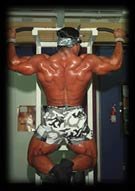The Three Part Back
 In bodybuilding, there are three things that you must have in order to have a successful back. They are: upper back thickness, width of the lats, and superb lower back development. Your upper back is the area that ties in your shoulders and arms to the rest of your back. The largest muscle in your upper back is the trapezius.
In bodybuilding, there are three things that you must have in order to have a successful back. They are: upper back thickness, width of the lats, and superb lower back development. Your upper back is the area that ties in your shoulders and arms to the rest of your back. The largest muscle in your upper back is the trapezius.
The trapezius, or traps as fellow "meat heads" calls them, are the triangular muscles from the base of the neck down to the mid-spine between the shoulder blades. Some people consider the traps to be part of the shoulder region, and that s ok. Others, myself included, have found that they respond better when trained with the back, so I am including it as part of the upper back.
The traps basically look like a "V" starting right below your neck. Your lats are those huge muscles that look like wings right under your arms. They are used for pulling yourself up, or pulling an object down towards you. (Big lats can be the reason why some bodybuilders walk with their arms way out to their side; then again it might just be their over-inflated egos!) Your lower back consists of the insertion point of your lower lats, and the spinal erectors. If you look at a bodybuilder s back, you will see what looks like a Christmas tree right above his waist. That is the separation of his lower lats and spinal erector.
The Exercises
Shrugs: Shrugs are the bread and butter for building huge traps. There are many variations you can use. I will focus on one type, dumbbell shrugs. Simply grab a pair of dumbbells, holding them at your sides. Shrug your shoulders as high as they can go, and hold it for a second, then slowly lower and repeat. Do not roll your shoulders. Rolling them does nothing to improve your trap development.
Seated V-bar Cable Rows: This exercise is a good exercise to hit your mid-upper back. V-bar cable rows are a basic back exercise that is very easy for beginners to do. The two most important things to remember are to always use your hands as hooks, and to keep your back straight. You can do this easily by lifting your chin, sticking out your chest, and slightly arching your lower back. Go to the cable machine and find the long bench. Most cable machines will have several areas to choose from.
 You need the long bench. Next grab a "V" shaped handle, it is the smallest handle to choose from. Now sit and face the machine, with your feet up on the foot stops. Pull the handle until it touches your lower rib cage, arching your back as you do so. As you pull the handle toward your body, make sure your elbows travel as far back as they can go.
You need the long bench. Next grab a "V" shaped handle, it is the smallest handle to choose from. Now sit and face the machine, with your feet up on the foot stops. Pull the handle until it touches your lower rib cage, arching your back as you do so. As you pull the handle toward your body, make sure your elbows travel as far back as they can go.
Now slowly lower the V-bar back and repeat. This is a great exercise for you re mid back. It will hit the lats, teres major, rear delts, and your lower traps and rhomboids at the end of the movement. The negative part of the movement deeply stretches the lats.
Now we are moving a bit lower, to those huge curtains of beef called the lats. Good lat development will give you that V-taper that all the girlies go for, the wide shoulders and lats, tapering down to a trim, tight waist. The lats are trained by doing any type of pull-down movement. The most basic exercise is the pull-up.
Bent-Over Barbell Rows: Rows will add thickness to your upper back area. Stand shoulder width apart, with a straight bar in front of you on the floor. Pick up the bar with shoulder width grip. (Grip can vary depending on what feels best for you; I suggest the grip that gives you the most power). Bend your knees slightly; lean forward until your upper body is parallel to the floor. Keep your back straight, with your head up. Lift the bar up, using your back muscles, until it touches your upper abdominal area. Lower it slowly and under complete control. It is really easy to let your arms do all the work. You need to mentally focus on making your back to all the work and just using your arms as tools, or hooks to train your back.
 The Pull-up: The grip is personal, but I suggest at least shoulder width overhand grip, try to go a little wider if you can. Hang from the bar and pull your self up until your upper chest touches the bar. Try to imagine pushing your elbows even more toward the floor, this will really contract the lats. Now slowly lower your body all the way down and repeat. If you've never done these before you probably wont get many the first time. They are difficult, and you might need to start on a pull-up assist machine. I believe that basic exercises, like the pull-up will build a muscular, strong back. There are some variations on the pull-up, such as the lat pull-down.
The Pull-up: The grip is personal, but I suggest at least shoulder width overhand grip, try to go a little wider if you can. Hang from the bar and pull your self up until your upper chest touches the bar. Try to imagine pushing your elbows even more toward the floor, this will really contract the lats. Now slowly lower your body all the way down and repeat. If you've never done these before you probably wont get many the first time. They are difficult, and you might need to start on a pull-up assist machine. I believe that basic exercises, like the pull-up will build a muscular, strong back. There are some variations on the pull-up, such as the lat pull-down.
Pull-down: The pull-down is done the same way but at a cable station. Make sure the pad is holding your legs down firmly. This is an alternative to the pull-up assist machine. Once again, I suggest using a wide over handgrip. Pull the bar down to your chest, using your back to pull down and not your arms or your bodyweight. Always move in a controlled manner, never using momentum to do the work for you. You can perform an easy variation, by grabbing the bar with an underhand grip shoulder width apart. This will hit your lats from a slightly different angle.
There are many other exercises for your lats, but for a beginner, theses two exercises should do you well. As a beginner I would suggest the following workout for the first 16 weeks:
Pullup or assisted pullup: Do as many sets as needed until you reach 25
Bent over barbell row: 4 sets: Keep the weight light enough to reach 15 reps each time
Overhand lat pulldown: 4 sets: Keep the weight light enough to reach 15 reps each time
V-bar cable row: 4 sets: Keep the weight light enough to reach 15 reps each time
Dumbell shrugs: 4 sets: Keep the weight light enough to reach 15 reps each time
Pullup or assisted pullup: Do as many sets as needed until you reach 30
Rely more on pullups, and less on the assist machine
Bent over barbell row: 4 sets: 15, 12, 12, 10 (you should only get 10 on your last set)
Overhand lat pulldown: 4 sets: 15, 12, 12, 10 (you should only get 10 on your last set)
V-bar cable row: 4 sets: 15, 12, 12, 10 (you should only get 10 on your last set)
Dumbell shrugs: 4 sets: 15, 12, 12, 10 (you should only get 10 on your last set)
Click Here For A Printable Log Of Nick's Back Workout
You might think that sixteen weeks is a long time to stay at the lighter weights, but I strongly believe that you should spend a lot of time creating superior mind-muscle links, muscle memory, and a habit of perfect form. If you do this, than adding weight will not cause your form to suffer. On a personal note, this is how I was taught to train my back 12 months ago.
Since that first 16-week period, my strength has gone up dramatically, due to my understanding of correct form. If you have the patience to learn it right the first time, your experience in and out of the gym will be rewarding.
Train Smart,
